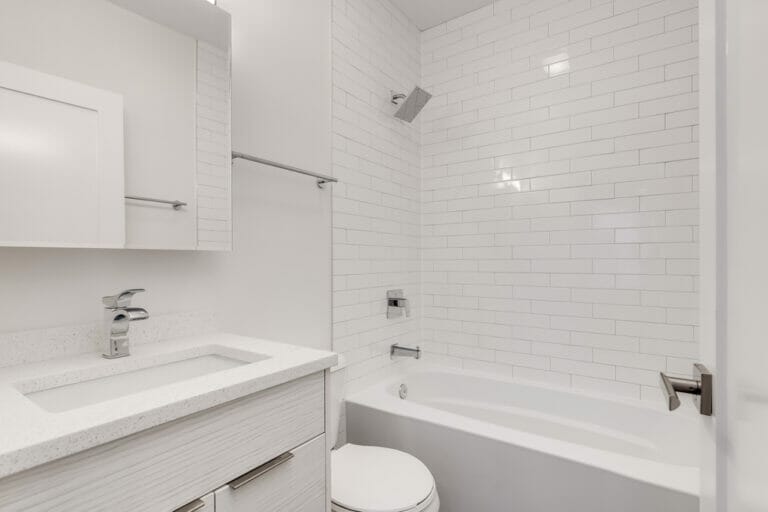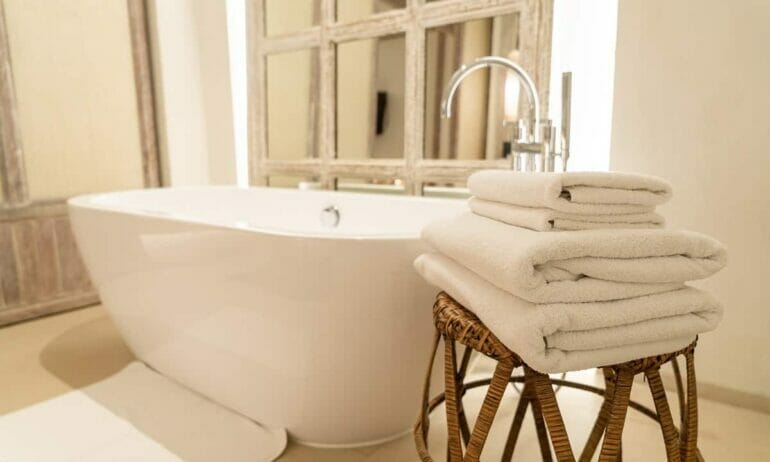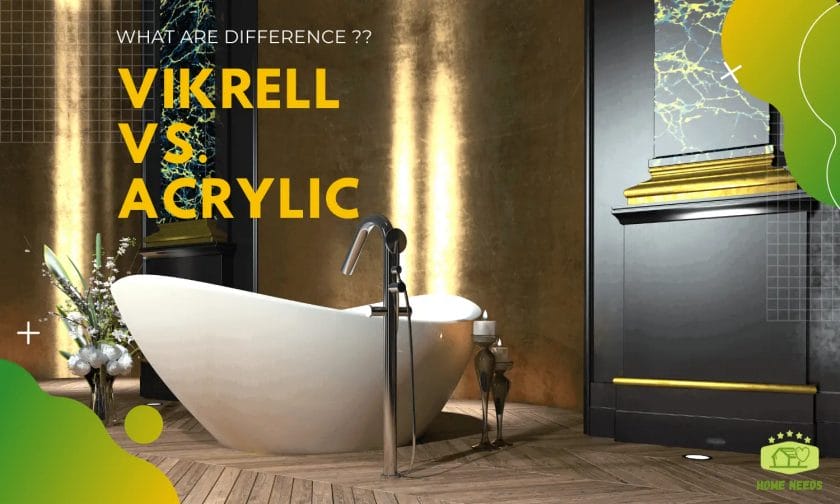Vikrell and acrylic are both popular options for bathroom fixtures and showers. However, when it comes to choosing between the two, it ultimately depends on your specific needs and preferences.
Vikrell is a solid surface material made from a composite of resins, fiberglass, and filler materials. It is known for its durability, strength, and resistance to chipping and cracking.
Acrylic, on the other hand, is a type of plastic that is lightweight, easy to maintain, and offers a wide range of color options. It is also less prone to fading and yellowing over time.
Ultimately, the choice between Vikrell and acrylic comes down to personal preference, budget, and the specific requirements of your bathroom project.

Durability and Longevity: Vikrell vs. Acrylic
When it comes to choosing a material for your bathroom fixtures, durability and longevity are key factors to consider. Two popular options on the market are Vikrell and acrylic. Both materials have their own unique advantages and disadvantages, so it’s important to understand the differences before making a decision.
Vikrell
Vikrell is a composite material made from a blend of resins, fiberglass, and fillers. It was developed by Sterling Plumbing, a leading manufacturer of bathroom fixtures. One of the main advantages of Vikrell is its exceptional durability. It is highly resistant to chipping, cracking, and impact, making it a great choice for high-traffic bathrooms or households with children. Vikrell fixtures are also resistant to stains and fading, ensuring that they maintain their appearance over time.
In terms of longevity, Vikrell fixtures have a reputation for lasting many years without showing signs of wear. The material is non-porous, which means it is resistant to mold, mildew, and bacteria growth. This makes it easy to clean and maintain, and reduces the risk of stains or odors developing over time.
Another advantage of Vikrell is its ability to retain heat. This means that when you fill a Vikrell bathtub with hot water, the material will keep the water warm for longer periods of time compared to other materials. This can be a major benefit for those who enjoy long, relaxing baths.
Acrylic
Acrylic is another popular material used in the manufacture of bathroom fixtures. It is a synthetic material made from polymethyl methacrylate (PMMA), a type of thermoplastic. Acrylic fixtures are known for their smooth, glossy finish and are available in a wide range of colors and styles.
When it comes to durability, acrylic is generally considered to be a strong and resilient material. It is resistant to cracks, chips, and impacts, although it may not be as durable as Vikrell in this regard. However, acrylic fixtures are prone to scratching, so it’s important to use gentle cleaning products and avoid abrasive materials.
Acrylic fixtures can also fade over time, especially when exposed to direct sunlight. This can result in a loss of vibrancy and a less appealing appearance. However, modern acrylic fixtures are often treated with UV inhibitors to reduce the risk of fading.
In terms of longevity, acrylic fixtures can last for many years with proper care and maintenance. Regular cleaning and avoiding harsh chemicals will help preserve the material’s integrity and appearance.
Choosing the Right Material
When deciding between Vikrell and acrylic for your bathroom fixtures, it’s important to consider your specific needs and preferences. If durability and resistance to impact are your top priorities, Vikrell may be the better choice. Its ability to retain heat and resistance to mold and mildew are also major advantages.
On the other hand, if you prefer a wider range of colors and styles, acrylic may be the better option. It offers a sleek, modern look and can be a great way to add a pop of color to your bathroom design. Just keep in mind that acrylic may require more frequent maintenance and care to prevent scratches and fading.
In summary, both Vikrell and acrylic offer their own set of advantages and disadvantages when it comes to durability and longevity. Consider your specific needs and preferences, and choose the material that best suits your bathroom design and lifestyle.

Maintenance and Cleaning: Choosing Between Vikrell or Acrylic
When it comes to choosing the right material for your bathroom fixtures and surfaces, maintenance and cleaning are important factors to consider. Two popular options for bathtubs and showers are Vikrell and acrylic. Both materials have their own advantages and disadvantages, so it’s essential to understand how they differ in terms of maintenance and cleaning.
Vikrell:
Vikrell is a composite material made from a blend of resins, fiberglass, and filler materials. It is known for its durability and resistance to cracking and chipping. When it comes to maintenance, Vikrell offers several benefits:
- Easy to clean: Vikrell surfaces have a smooth and non-porous finish, making them resistant to dirt and stains. Regular cleaning with mild soap and water is usually sufficient to keep Vikrell surfaces looking clean and fresh.
- Low maintenance: Unlike natural materials like stone or tile, Vikrell does not require sealing or special treatment. This makes it a low-maintenance option that can save you time and effort in the long run.
- Scratch-resistant: Vikrell surfaces are less prone to scratches compared to acrylic. However, it is still important to avoid abrasive cleaners or scrub brushes that can cause damage to the surface.
Acrylic:
Acrylic is another popular choice for bathtubs and showers. It is a lightweight and cost-effective material that offers several advantages. Here’s what you need to know about the maintenance and cleaning of acrylic:
- Easy to clean: Like Vikrell, acrylic surfaces are smooth and non-porous, making them easy to clean. Regular cleaning with mild soap and water is usually sufficient to remove dirt and stains.
- Stain-resistant: Acrylic is resistant to staining, which means that common bathroom products like shampoo or soap are unlikely to cause discoloration. However, it is still important to clean up any spills or splashes promptly to prevent potential staining.
- Can be scratched: While acrylic is generally durable, it is more prone to scratches compared to Vikrell. To prevent scratching, it’s best to use non-abrasive cleaners and soft cloths or sponges when cleaning acrylic surfaces.
Choosing the Right Option:
When deciding between Vikrell and acrylic, it’s important to consider your specific needs and preferences. Both materials offer easy maintenance and cleaning, but there are some differences to keep in mind:
- Durability: Vikrell is known for its durability and resistance to cracks and chips, making it a great choice for high-traffic bathrooms or households with children.
- Scratch-resistance: If scratch-resistance is a top priority for you, Vikrell may be the better option.
- Budget: Acrylic is generally more affordable compared to Vikrell, making it a popular choice for those on a tighter budget.
- Aesthetics: Consider the overall look and feel you want to achieve in your bathroom. Both Vikrell and acrylic come in a variety of colors and styles, so choose the one that complements your design vision.
In summary, both Vikrell and acrylic offer easy maintenance and cleaning for your bathroom fixtures. Vikrell is known for its durability and scratch-resistance, while acrylic is more budget-friendly. Ultimately, the choice between the two depends on your specific needs, budget, and aesthetic preferences.

Cost Considerations: Is Vikrell or Acrylic a Better Investment?
When it comes to choosing between Vikrell and acrylic for your project, cost is an important factor to consider. Both materials have their own advantages and disadvantages, and understanding how they compare in terms of cost can help you make an informed decision.
Vikrell:
Vikrell is a composite material made from a combination of resin, fiberglass, and filler materials. It is known for its durability and resistance to damage, making it a popular choice for bathrooms and kitchens. In terms of cost, Vikrell tends to be more affordable compared to other options such as solid surface or natural stone.
One of the main cost advantages of Vikrell is its lower initial price. The material itself is less expensive than acrylic, which means that the overall cost of a Vikrell project can be significantly lower. Additionally, Vikrell is relatively easy and cost-effective to install, as it can be molded and shaped to fit any space without the need for specialized tools or equipment.
Furthermore, Vikrell requires minimal maintenance and is resistant to stains, scratches, and fading. This can save you money in the long run, as you won’t have to invest in expensive cleaning products or repairs. Additionally, Vikrell’s durability ensures that it will last for many years, reducing the need for frequent replacements or renovations.
Acrylic:
Acrylic is a popular choice for bathroom fixtures and shower surrounds due to its versatility and aesthetic appeal. While acrylic is generally more expensive than Vikrell, it offers certain advantages that may justify the higher initial cost.
One of the main benefits of acrylic is its luxurious appearance. It has a smooth and glossy finish that can elevate the look of any space, giving it a high-end feel. Additionally, acrylic is available in a wide range of colors and designs, allowing for customization and personalization.
Another advantage of acrylic is its durability. It is resistant to chipping, cracking, and fading, which means that it will maintain its original appearance for a longer period of time. This can be particularly beneficial if you are looking for a long-term investment that will retain its value.
While acrylic may require more maintenance compared to Vikrell, proper care and cleaning can ensure its longevity. Regular cleaning with non-abrasive products can help prevent the buildup of dirt and grime, reducing the risk of scratches or damage. It is worth noting that any repairs or replacements for acrylic fixtures may be more costly compared to Vikrell, so it is important to factor this into your budget.
Conclusion:
When it comes to cost considerations, both Vikrell and acrylic have their own advantages and disadvantages. Vikrell tends to be more affordable in terms of initial cost and maintenance, making it a budget-friendly option. On the other hand, acrylic offers a luxurious appearance and long-term durability, which may justify its higher price tag. Ultimately, the choice between Vikrell and acrylic depends on your budget, aesthetic preferences, and the level of durability you require for your project.
Aesthetics and Design: Choosing the Right Material for Your Needs
When it comes to aesthetics and design, choosing the right material is crucial. The material you select not only impacts the visual appeal of your project but also plays a significant role in its functionality and durability. With a wide range of materials available in the market, it can be overwhelming to make the right choice. In this section, we will explore the factors you should consider when selecting a material for your project and provide insights into some popular options.
Factors to Consider
Before diving into the different materials, it is important to assess the specific requirements of your project. Here are some key factors to consider:
- Aesthetic Appeal: The material you choose should align with your desired aesthetic. Consider factors such as color, texture, and pattern to ensure the material complements the overall design.
- Durability: Depending on the application, durability may be a critical factor. Evaluate the material’s resistance to wear, impact, moisture, and other environmental factors to ensure it can withstand the intended use.
- Maintenance: Consider the level of maintenance required for the material. Some materials may require regular upkeep, while others are more low-maintenance.
- Cost: Your budget plays a significant role in material selection. Evaluate the cost of the material, including installation and long-term maintenance expenses.
- Sustainability: If eco-friendliness is a priority, opt for materials that are sustainable and environmentally friendly.
Popular Material Options
Now that you have a clear understanding of the factors to consider, let’s explore some popular material options for various applications:
1. Wood
Wood is a timeless material that adds warmth and natural beauty to any design. It is highly versatile and can be used for both interior and exterior applications. From hardwoods like oak and mahogany to softwoods like pine and cedar, there are numerous wood species to choose from. The choice of wood will depend on factors such as durability, aesthetics, and budget.
2. Metal
Metal materials such as steel, aluminum, and brass are known for their strength and durability. These materials are often favored for their modern and sleek appearance. Metal can be used in various applications, ranging from architectural structures to decorative elements. Consider the specific properties of each metal, such as corrosion resistance and finish options, before making a decision.
3. Stone
Stone materials like granite, marble, and limestone offer a luxurious and elegant look. They are commonly used in countertops, flooring, and wall cladding. Stone is known for its durability and natural variation in color and pattern. However, it can be more expensive and requires regular maintenance to preserve its appearance.
4. Glass
Glass is a versatile material that adds a touch of sophistication to any design. It is commonly used in windows, doors, and decorative elements. Glass comes in various forms, including clear, frosted, and stained glass. Consider factors such as transparency, thickness, and safety requirements when selecting glass for your project.
5. Composite Materials
Composite materials are engineered products made by combining two or more materials. They offer a balance of durability, aesthetics, and functionality. Examples of composite materials include fiber cement, engineered wood, and fiberglass. These materials are often used in exterior cladding, decking, and furniture. Evaluate the specific properties of each composite material to ensure it meets your project’s requirements.
In summary, choosing the right material for your project involves considering factors such as aesthetic appeal, durability, maintenance, cost, and sustainability. By carefully assessing these factors and exploring various material options, you can make an informed decision that enhances the aesthetics and functionality of your design.
FAQs
What is the difference between Vikrell and acrylic?
Vikrell is a solid surface material made from a combination of resin, fiberglass, and filler materials, while acrylic is a type of plastic. Vikrell offers more durability and resistance to scratches, stains, and fading compared to acrylic. Additionally, Vikrell has a higher resistance to impact and is less likely to chip or crack.
Can Vikrell be repaired if it gets damaged?
Yes, Vikrell can be repaired if it gets damaged. Small scratches and cracks can often be repaired using a repair kit specifically designed for Vikrell. However, larger damages may require professional assistance to ensure a proper and long-lasting repair.
Is acrylic more affordable than Vikrell?
Generally, acrylic is more affordable compared to Vikrell. Acrylic is a widely available and cost-effective material, making it a popular choice for many homeowners. Vikrell, on the other hand, is a premium material that offers enhanced durability and performance, which may come with a higher price tag.
Conclusion
In conclusion, when it comes to choosing between Vikrell and acrylic, it ultimately depends on your specific needs and preferences. Vikrell is a durable and resilient material that is resistant to chipping and cracking, making it ideal for high-traffic areas. On the other hand, acrylic is known for its versatility and easy maintenance, offering a wider range of design options. Whether you prioritize durability or flexibility, both materials have their unique advantages. It is recommended to consider factors such as budget, style, and functionality before making a final decision. Ultimately, the best choice is the one that aligns with your individual requirements and aesthetic vision.
